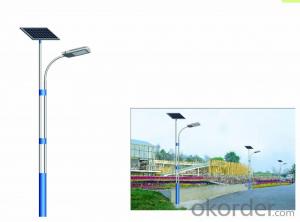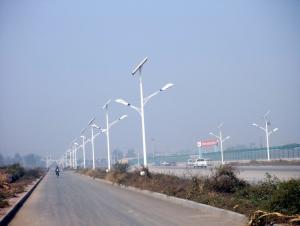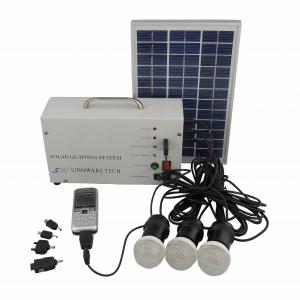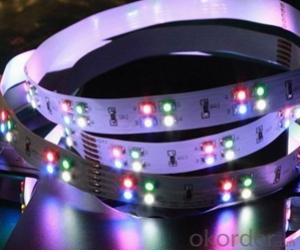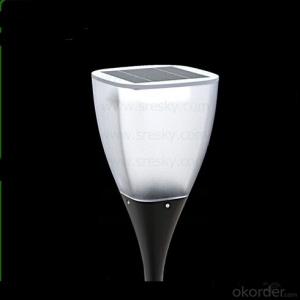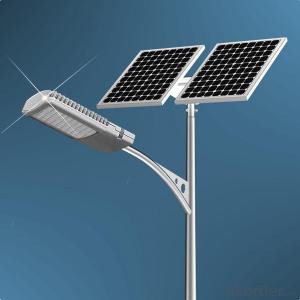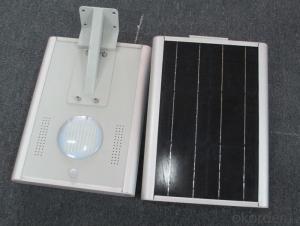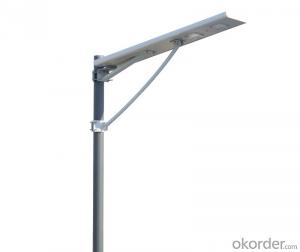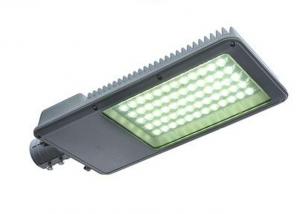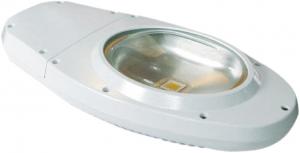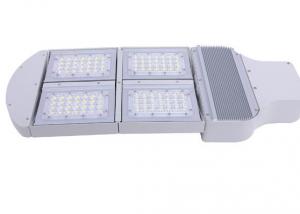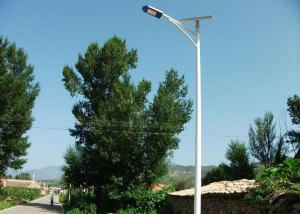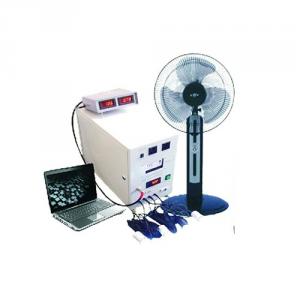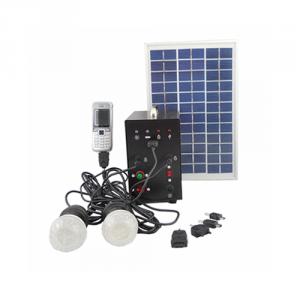Solar Light Solar Product Off Grid New Energy 025NM
- Loading Port:
- Shanghai
- Payment Terms:
- TT OR LC
- Min Order Qty:
- 1 watt
- Supply Capability:
- 5000 watt/month
OKorder Service Pledge
OKorder Financial Service
You Might Also Like
1, Product desciption
Inverter circuits designed to produce a variable output voltage range are often used within motor speed controllers.
The DC power for the inverter section can be derived from a normal AC wall outlet or some other source. Control and feedback circuitry is used to adjust the final output of the inverter section which will ultimately determine the speed of the motor operating under its mechanical load.
Motor speed control needs are numerous and include things like: industrial motor driven equipment, electric vehicles, rail transport systems, and power tools. (See related: variable-frequency drive ) Switching states are developed for positive, negative and zero voltages as per the patterns given in the switching Table.
The generated gate pulses are given to each switch in accordance with the developed pattern and thus the output is obtained.
Solar power is energy from the sun. "Solar" is the Latin word for "sun" and
And Powerful source of energy. Without it, there will be no life.
Solar energy is considered as a serious source of energy for many years
of the vast amounts of energy that is made freely available, if harnessed by modern technology.
A magnifying glass can be used to heat up a small amount of water.
The short piece of copper tube is sealed at one end and filled with water.
And magnifying glass is then used to warm up the pipe.
Using more than one magnifying glass will increase the temperature more rapidly.
2, Features of the product
Inverters convert low frequency main AC power to higher frequency for use in induction heating.
To do this, AC power is first rectified to provide DC power. The inverter then changes the DC power to high frequency AC power. Due to the reduction in the number of DC Sources employed, the structure becomes more reliable and the output voltage has higher resolution due to an increase in the number of steps so that the reference sinusoidal voltage can be better achieved.
This configuration has recently become very popular in AC power supply and adjustable speed drive applications. This new inverter can avoid extra clamping diodes or voltage balancing capacitors. There are three kinds of level shifted modulation techniques, namely: 1,High and stable conversion efficienly based on over 4 years professional experience
2 ,High reliability with guaranteed +/-10% output power tolerance
3,Proven materials,tempered front glass,and a sturdy anodized aluminum frame allow modules to operate reliably in multiple mountily configurations
4,Combination of high efficicncy and attractive appearance
The first thing to figure out is the length of road in need of street lights.
This can be a small entrance road only a couple hundred of feet long to miles of streets through an area. Does the area currently have any type of lighting available.
What is the reason for needing street lights in this area
Is the electrical grid already nearby or would you need to call in the power company to bring in electrical lines.
If the electric needs to be brought to the area, how much is this going to cost? Depending on how far the grid electric is from the location of the needed lighting, this can be quite expensive.
How much lighting is needed on the street? Do the lights need to be dark sky compliant.
Do the street lights need to run from dusk to dawn or for only a specified number of hours at night.
Are the street lights able to dim in the middle of the night and still provide enough lighting.
These questions need to be answered before you can decide on how many lights you will need to complete the project.
Grid-tie inverters that are available on the market today use a number of different technologies. The inverters may use the newer high-frequency transformers, conventional low-frequency transformers, or no transformer. Instead of converting direct current directly to 120 or 240 volts AC, high-frequency transformers employ a computerized multi-step process that involves converting the power to high-frequency AC and then back to DC and then to the final AC output voltage.
Historically, there have been concerns about having transformerless electrical systems feed into the public utility grid. The concerns stem from the fact that there is a lack of galvanic isolation between the DC and AC circuits, which could allow the passage of dangerous DC faults to be transmitted to the AC side. Since 2005, the NFPA's NEC allows transformerless (or non-galvanically) inverters. The VDE 0126-1-1 and IEC 6210 also have been amended to allow and define the safety mechanisms needed for such systems. Primarily, residual or ground current detection is used to detect possible fault conditions. Also isolation tests are performed to insure DC to AC separation.
Many solar inverters are designed to be connected to a utility grid, and will not operate when they do not detect the presence of the grid. They contain special circuitry to precisely match the voltage and frequency of the grid.
A charge controller may be used to power DC equipment with solar panels. The charge controller provides a regulated DC output and stores excess energy in a battery as well as monitoring the battery voltage to prevent under/over charging. More expensive units will also perform maximum power point tracking. An inverter can be connected to the output of a charge controller to drive AC loads.
3, Detailed Specification
Data Sheet of High Quality Solar Controller Tracer-1210RN
ModelTracer-1210RN
Rated system voltage12/24V auto work
Rated battery current10A
Rated load current10A
Max.battery voltage32V
Max.PV open circuit voltage100VDC
Max.PV input power12V 130W;24V 260W
Self-consumption<10ma(24v)< span="">
Charge Circuit Voltage<=0.26v< span="">
Discharge Circuit Voltage Drop<=0.15v< span="">
CommunicationTTL232/8 pin RJ45
Temp/compensation-30mV/℃/12V(25℃)
Working temperature-35℃~+55℃
Storage temperature range-35℃~+55℃
4, Product Image

- Q:Can solar lights be used in urban areas?
- Yes, solar lights can be used in urban areas. In fact, they are an excellent solution for urban areas where access to electricity may be limited or costly. Solar lights are easy to install, require minimal maintenance, and are powered by renewable energy, making them a sustainable and efficient lighting option for urban environments.
- Q:Do solar lights require regular maintenance?
- Yes, solar lights require regular maintenance to ensure optimal performance. Some common maintenance tasks for solar lights include cleaning the solar panels, checking for debris or obstructions that may block the sunlight, and replacing any worn-out or damaged components such as batteries or bulbs. Regular maintenance also involves inspecting the wiring connections and making sure they are secure and not corroded. Additionally, it is important to periodically adjust the positioning of solar lights to maximize exposure to sunlight. By performing regular maintenance, solar lights can continue to function efficiently and provide adequate illumination for outdoor spaces.
- Q:Do solar lights have adjustable coverage areas for motion detection?
- Yes, some solar lights have adjustable coverage areas for motion detection.
- Q:Do solar lights have adjustable brightness settings for different lighting needs?
- Many solar lights are equipped with adjustable brightness settings to accommodate various lighting needs. These settings enable users to modify the intensity of the emitted light based on their specific requirements. Certain solar lights are designed with multiple brightness levels that can be effortlessly adjusted through a switch or button, while others offer the convenience of remote control or smartphone application adjustment. The ability to adjust brightness provides solar lights with flexibility, allowing for brighter illumination during tasks that demand more light, or dimmer lighting for creating an ambient or decorative atmosphere. This feature empowers users to personalize their lighting preferences and address specific lighting requirements in diverse outdoor settings.
- Q:Are solar lights resistant to lightning strikes?
- Solar lights are generally not resistant to lightning strikes. While solar lights are designed to be weatherproof and withstand various environmental conditions, they are not specifically designed to protect against lightning strikes. Lightning is a powerful discharge of electricity that can cause significant damage to any electronic device, including solar lights. If a lightning strike directly hits a solar light, it can damage or destroy the internal components, rendering the light inoperable. However, it is important to note that the likelihood of a lightning strike directly hitting a solar light is relatively low. Lightning tends to strike taller objects such as trees, buildings, or lightning rods, rather than smaller objects like solar lights. Additionally, solar lights are often installed in areas with lower risk of lightning strikes, such as residential gardens or pathways. To minimize the risk of damage from lightning strikes, it is recommended to install surge protectors or lightning arrestors in the electrical system that connects to the solar lights. These devices help divert lightning's electrical energy away from the lights, reducing the chances of damage. In conclusion, while solar lights are not resistant to lightning strikes, the likelihood of them being directly hit by lightning is relatively low. Taking precautions such as installing surge protectors can further reduce the risk of damage from lightning strikes.
- Q:How do solar lights handle electromagnetic noise?
- Solar lights are designed to handle electromagnetic noise by utilizing advanced circuitry and filters that minimize interference from external sources. These mechanisms ensure that the solar lights operate smoothly and efficiently, unaffected by electromagnetic noise or other disturbances.
- Q:Can solar lights be used for patio lighting?
- Yes, solar lights can be used for patio lighting. They are a popular and eco-friendly option for illuminating outdoor spaces, including patios. Solar lights harness the energy from the sun during the day and use it to power the lights at night. They are easy to install and do not require any electrical wiring, making them a convenient choice for patio lighting.
- Q:Can solar lights be used for illuminating outdoor dining areas?
- Yes, solar lights can be used for illuminating outdoor dining areas. Solar lights are a sustainable and environmentally friendly option for outdoor lighting. They rely on sunlight to charge their batteries during the day, and then they automatically turn on at night to provide illumination. Solar lights are typically easy to install and require no wiring, making them a convenient choice for outdoor dining areas. Additionally, many solar lights are designed with different brightness levels and settings, allowing you to adjust the lighting to create the desired ambiance for your dining area. Overall, solar lights are a great option for illuminating outdoor dining areas, providing both practical and aesthetic benefits.
- Q:What are the components of a solar light system?
- The components of a solar light system typically include solar panels, a battery or energy storage system, a charge controller, LED lights, and sometimes a motion sensor or timer.
- Q:Are solar lights suitable for hiking and trail lighting?
- Yes, solar lights are suitable for hiking and trail lighting. Solar lights are lightweight, portable, and do not require any electricity or batteries to operate. They are powered by the sun, which means they can be charged during the day and provide illumination at night. This makes them perfect for outdoor activities like hiking and trail lighting, where accessing electricity may be difficult or impractical. Solar lights are also environmentally friendly, as they do not produce any emissions or waste. Additionally, many solar lights are designed to be durable and weatherproof, ensuring they can withstand the rigors of outdoor environments. Overall, solar lights are a convenient and sustainable lighting solution for hiking and trail lighting.
1. Manufacturer Overview |
|
|---|---|
| Location | |
| Year Established | |
| Annual Output Value | |
| Main Markets | |
| Company Certifications | |
2. Manufacturer Certificates |
|
|---|---|
| a) Certification Name | |
| Range | |
| Reference | |
| Validity Period | |
3. Manufacturer Capability |
|
|---|---|
| a)Trade Capacity | |
| Nearest Port | |
| Export Percentage | |
| No.of Employees in Trade Department | |
| Language Spoken: | |
| b)Factory Information | |
| Factory Size: | |
| No. of Production Lines | |
| Contract Manufacturing | |
| Product Price Range | |
Send your message to us
Solar Light Solar Product Off Grid New Energy 025NM
- Loading Port:
- Shanghai
- Payment Terms:
- TT OR LC
- Min Order Qty:
- 1 watt
- Supply Capability:
- 5000 watt/month
OKorder Service Pledge
OKorder Financial Service
Similar products
New products
Hot products
Hot Searches
Related keywords
